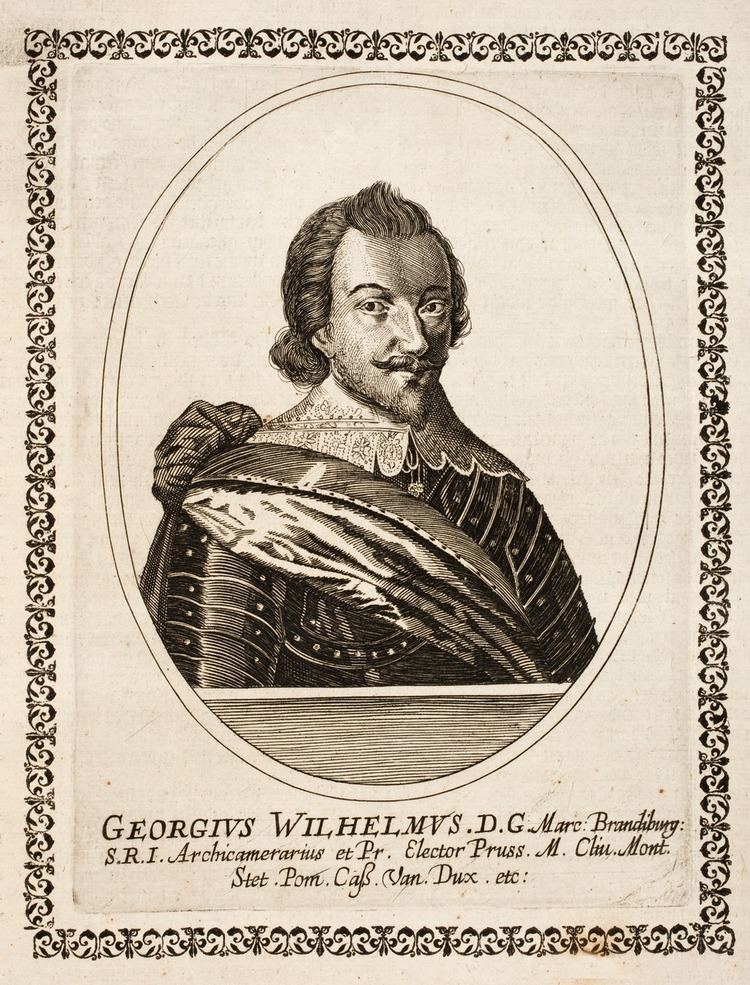Reign 1619–1640 Name George Elector | Predecessor John Sigismund | |
 | ||
Born 13 November 1595Colln ( 1595-11-13 ) Issue Louise Charlotte, Duchess of CourlandFrederick William, Elector of BrandenburgHedwig Sophia, Landgravine of Hesse-Kassel Died December 1, 1640, Konigsberg Spouse Elizabeth Charlotte of the Palatinate (m. 1616) Children Frederick William, Elector of Brandenburg Parents John Sigismund, Elector of Brandenburg, Duchess Anna of Prussia Similar People Frederick William - Elector of, John Sigismund - Elector of, Frederick I of Prussia, Maria Eleonora of Brandenburg, Countess Louise Henriette | ||
George William (German: Georg Wilhelm; 13 November 1595 – 1 December 1640), of the Hohenzollern dynasty, was margrave and elector of Brandenburg and duke of Prussia from 1619 until his death. His reign was marked by ineffective governance during the Thirty Years' War. He was the father of Frederick William, the "Great Elector".
Contents
Early life
Born in Cölln on the Spree (today part of Berlin), George William was the son of John Sigismund, Margrave of Brandenburg and Anna of Prussia. His maternal grandfather was Albert Frederick, Duke of Prussia. In 1616 George William married Elisabeth Charlotte of the Palatinate. Their only son Frederick William later became known as the "Great Elector". Of his two daughters, the eldest, Louise Charlotte, married Jacob Kettler, Duke of Courland, and the younger, Hedwig Sophie, married William VI, Landgrave of Hesse-Kassel.
Rule
In 1619 George William inherited the Margravate of Brandenburg and the Duchy of Prussia. He paid his feudal homage in person to the King of Poland, Sigismund III Vasa, in September 1621 in Warsaw (the Duchy of Prussia was a fief of the Kingdom of Poland at the time). The homage was renewed in 1633 after the election of a new Polish king, Władysław IV Vasa. During the Thirty Years' War, the Reformed George William tried to remain neutral between the Roman Catholic forces of the Holy Roman Empire and the Protestant principalities. As his sister Maria Eleonora of Brandenburg was queen of Sweden, George William had to maneuver between requests of assistance from his Lutheran brother-in-law King Gustavus Adolphus of Sweden and his own Protestant counsellors on one side and his Catholic chancellor Count Adam von Schwarzenberg on the other.
Despite his attempts at neutrality, George William was forced by Gustavus Adolphus, since 1626 occupying Ducal Prussia's access to the sea, to join the Protestant forces in 1631. His rule was largely weak and ineffective, as much of government responsibilities in Brandenburg-Prussia was turned over to Schwarzenberg as the country suffered greatly during the war. Protestant and Catholic troops alike burned and plundered the Brandenburg region and the population was decimated there as it was throughout the German states. Whereas Ducal Prussia remained mostly untouched.
With his brother-in-law Gustavus dead in 1632, George William maintained the Swedish alliance until after the Swedish defeat at the Battle of Nördlingen on 6 September 1634. At that point, George William withdrew Brandenburg from the war and signed the Peace of Prague with Emperor Ferdinand II on 30 May 1635. Leaving Schwarzenberg in charge of the government, George William withdrew in 1637 to the relatively safe region of Ducal Prussia, where he lived in retirement until his death at Königsberg in Prussia in 1640.
